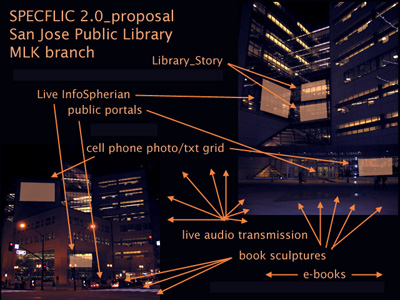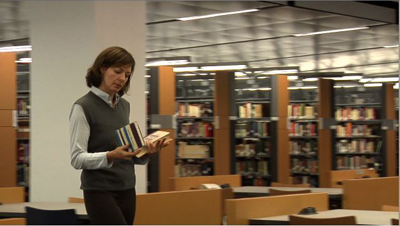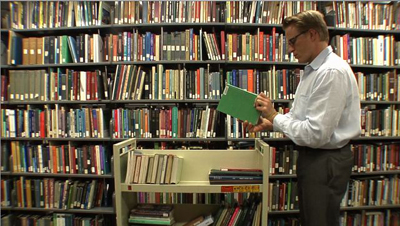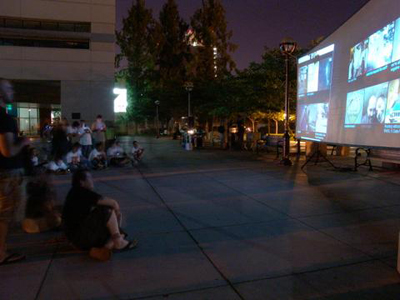New Form of Cinema Promoted by UC San Diego New-Media Artist at San Jose Festival
By Doug Ramsey, 858-822-5825, dramsey@ucsd.edu
San Jose and San Diego, CA, August 23, 2006 -- The Martin Luther King Jr. Public Library in San Jose , CA , was transformed in early August into a public library circa 2030. Part of ZeroOne San Jose, the city’s inaugural high-tech arts festival, the transformation was part of SPECFLIC 2.0, a site-specific multimedia event designed to explore the intersection of digital media, books and reading. Live performative media and pre-recorded video were projected on multiple surfaces of the library, and the public provided some of the content—via camera phones, text messaging and interaction with performers.
|
"It was exciting to see my vision manifest publicly," said SPECFLIC creator Adriene Jenik, Associate Professor of Computer & Media Arts in UCSD's Visual Arts Department.. "I think people got a sense of the potential of the form I am trying to develop. The piece seemed to be understood and greatly appreciated, with many personal and collective moments which came as surprises or revelations rather than as plot points."
"Roughly 500 to 600 people turned out and they were really into it and participating," noted Todd Margolis, technical director of SPECFLIC 2.0 and a staffer in UCSD's Center for Research in Computing and the Arts (CRCA). "They were following the story line and asking lots of questions. The format was streamlined compared to the first version of SPECFLIC, so the narrative came through a lot stronger."
SPECFLIC 1.0 took place last October at the dedication of Calit2's headquarters building at UCSD. This time, for the 2.0 version, Jenik developed the story based on the new library locale. She also pared down the number of themes and characters: SPECFLIC 2.0 involved only four characters (although one of them rotated through three roles), compared to nearly a dozen characters in version 1.0.
Jenik says she is developing SPECFLIC as a new form of cinematic experience that she originally dubbed "speculative distributed cinema." Now she prefers to call it by a different moniker. "A friend, critic and artist, Sarah Lewison, who helped us on this project, coined the term 'social cinema'," explained Jenik. "I think that is more appropriate."
|
SPECFLIC 2.0 portrays 2030 as a time in which audio-visual media dominate, and the next generation of students and scholars develop within an InfoSphere where libraries in their current form are no longer open to the public. Rather, access to the library is through the InfoSpherian, a "live" character that morphs among three distinct 'InfoFaces': an archetypal librarian and library docent (FLO); CORE, a reading-license enforcer; and Hypertia, who helped questioners navigate the InfoSphere.
"Adriene's not proposing the death of the library," observed CRCA's Margolis, "but rather its transformation."
"The library information desk was the perfect entry point into the narrative," said Jenik. "At one point there were 30 or 35 people lined up to request something of the InfoSpherian. She had a script but also had to improvise different responses to requests."
The actress playing the InfoSpherian, Praba Pilar, was able to control how she looked and sounded depending on the function she was assuming. The Max/MSP Jitter interface software was programmed by Luke Wylie, a former Interdisciplinary Computing and the Arts (ICAM) major at UCSD who is extending his undergraduate career to prepare for a medical degree. The public portal opened every few minutes, allowing anyone in the audience to talk directly to the InfoSpherian, or to ask questions.
|
|
The fourth character in the narrative, the Wandering FoolBook (played by Melissa Lozano), was a homeless poet who roamed the library grounds. Her running commentary was interlaced with a stream of interviews produced by Neighborhood Public Radio artists who contributed pre-recorded and live reflections on the future of the book, the library and the written word.
One element that debuted in SPECFLIC 1.0 at Calit2 - the SousVeillance Grid -- was expanded and refined for 2.0 by former Calit2 undergraduate scholar and ICAM alumnus Andrew Collins. The grid was projected on a 40x50-foot space on the exterior of the library facing the main thoroughfare (San Fernando Street), as well as in a smaller space facing the courtyard. The grid - two frames high and three frames across - featured a constantly changing mix of photos submitted in real time from cell phone cameras via the Internet.
A dozen AP English students from Prospect High School, dubbed the Poetxt team, were recruited by ZeroOne education fellow Gina Campanella to wander through the crowd taking snapshots with camera phones and adding commentary to images in an attempt to reflect the themes of the event through sms poetry.
|
For the SousVeillance Grid, 20 RAZR camera cell phones were donated by Motorola -- a donation valued at more than $5,000. "The RAZR phones were important to the success of SPECFLIC," said UCSD development executive Jim Shea. "They pushed audience engagement in the experience to a much higher level than was possible during last October's performance, making this performance much truer to Adriene's vision."
Jenik estimates that staging SPECFLIC 2.0 might have cost $250,000, but for the donated time, equipment and facilities that allowed her to bring the project in for a fraction of that amount. "SPECFLIC 2.0 was fully realized," she said, "even with an extremely limited budget and mostly with volunteer support."
Several staffers from Calit2's visualization division were on hand in San Jose to help with the complicated technical setup, including Hector Bracho. Jim Shea, who secured the Motorola phone donation, was also there. Calit2 senior development engineer Ganz Chockalingam adapted his cell phone-based Call-2-Communicate system for use in SPECFLIC, but a last-minute glitch prevented its use during the live event (along with text messages written expressly for SPECFLIC by science-fiction author Rudy Rucker). Jenik plans to incorporate this element into future documentation screenings and live iterations.
|
For her part, Jenik came away from SPECFLIC 2.0 convinced that it had raised important issues for the public - and public libraries. "As a result of increased digitization of holdings, there is a public dialogue going on right now about the shifting role of public libraries," said Jenik. "Librarians know the importance of the library as a cultural institution that supports free and open public access to knowledge."
Specifically, Jenik now thinks that future incarnations of SPECFLIC should also focus thematically on the public library. "I can continue the site specificity of certain elements, but also take on this profoundly urgent and important shift over time, as well as make use of the many beautiful new library buildings that exist worldwide," she suggested. "I now realize that my research effort can best be exploited by accumulating ongoing research and getting deeper into understanding of the issues, but focusing it on the specific locale. I'm excited about growing the project in that direction."
The UCSD artist is digesting what worked and what didn't work in San Jose, and is already scheduled to deliver presentations about SPECFLIC to upcoming conferences in Athens, Greece (Medi@terra 2006, October 4-8), Bloomington, Indiana (Perform.Media, September 29-October 14), and even Hollywood, where she'll be on a Film Independent panel to discuss the future of cinema at the Screen Actors Guild on September 19.
Related Links
SPECFLIC
ZeroOne San Jose
Adriene Jenik Website
Center for Research in Computing and the Arts







